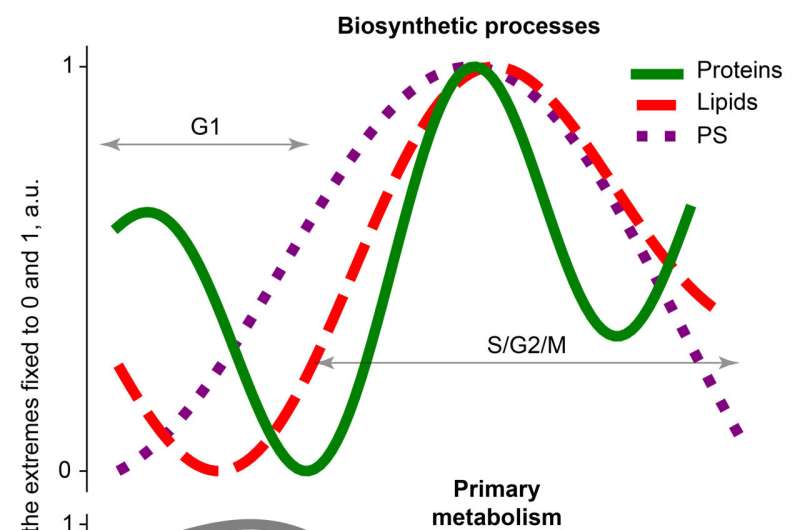This article has been reviewed according to Science X's editorial process and policies. Editors have highlighted the following attributes while ensuring the content's credibility:
fact-checked
peer-reviewed publication
trusted source
proofread
Cells avoid multitasking: Examining the cause of metabolic oscillations that lead up to cell division

Textbooks will tell you that in dividing cells, the production of new DNA peaks during the S-phase, while production of other macromolecules, such as proteins, lipids, and polysaccharides, continues at more or less the same level.
Molecular biologists at the University of Groningen, led by professor Matthias Heinemann, have now discovered that this is not true: protein synthesis shows two peaks, and lipid synthesis peaks once. These shifts could explain the metabolic oscillations that lead up to cell division, which the group has discovered previously. Their new results were published in Nature Metabolism on February 27.
Every dividing eukaryotic cell passes through the cell cycle: from a growth phase (G1) to a phase with synthesis of new DNA (S), a gap phase (G2), and finally a phase with cell division through mitosis (M). Scholarly texts on cell division will tell you that apart from the synthesis of DNA, all other molecules in the cell, such as proteins, lipids, and polysaccharides, are produced at a more or less constant rate throughout all cell cycle phases.
Dynamic measurements
Seven years ago, Matthias Heinemann and his group described oscillations in cell metabolism, which appeared to orchestrate the process of eukaryotic cell division. His team has now studied the metabolism in more detail and measured the rate at which proteins, lipids, and polysaccharides are produced during the cell cycle. And they discovered that the textbooks are wrong.
"We have used dynamic microscopic measurements in single cells to show how the production of different macromolecules peaks at different times," explains Heinemann. The basic rate of protein synthesis peaked during the G1 phase, subsided in the S phase, and peaked again in the second half of the cell cycle. "We also found that synthesis of both lipids and polysaccharides, the building blocks for the cell wall, peaks only once: also in the second half."
Building blocks
To determine the protein synthesis rate, the scientists used an established method of monitoring fluorescent proteins. They also devised a second, more sophisticated method, through which they could validate that protein production appeared to follow the two-wave pattern.
"We had to develop this second method because our results were going against what we and everybody else knew about cell cycle metabolism," says Vakil Takhaveev, the first author of the paper. "In this novel method, we probed how sensitive a cell is to an inhibitor of protein biosynthesis at each moment of the cell cycle. It turned out that this sensitivity has peaks at different phases of the cell cycle."
In their Nature Metabolism paper, Heinemann and his team show that the different building blocks for cells are not produced at the same time. Moreover, the researchers showed that the entire central metabolism has to change to satisfy this temporally segregated production of building blocks. For example, they found that the rate of glucose consumption, ethanol excretion, and respiration are allocated to specific phases of the cell cycle.
Interestingly, these new measurements concur with their earlier findings, explains Heinemann: "The cell must activate different biosynthetic pathways to produce amino acids or lipids. This produces changes in metabolite flows and that explains why we previously found metabolic oscillations during cell division."
However, this leaves the question as to how exactly this happens and why. "At the moment, we can only speculate," says Heinemann. "One aspect is that if a cell simply grows, all building blocks are required at the same time. But during division, the situation is more complex. It might well be that the sequence of production can help the cell with division."
Cancer and aging
Osmotic pressure could be the key to that. "Think about blowing up a balloon. At first, you need really high pressure, but once it starts to expand, a lower pressure is enough. Maybe the cell first produces a lot of proteins to increase osmotic pressure inside the cell, which could help in splitting off the daughter cell," says Heinemann. "Again, this is just speculation, but I do feel that there is a biophysical reason behind the patterns that we observed."
He will pursue these ideas and search for the regulating mechanisms that are responsible for the different phases in the synthesis of cellular building blocks. "We don't know yet how this works, but it would be extremely interesting to find out and to see how these regulatory systems might be perturbed." The current findings and future work are necessary for the fundamental understanding of cellular physiology and will eventually help us to tackle cancer and aging.
More information: Matthias Heinemann, Temporal segregation of biosynthetic processes is responsible for metabolic oscillations during the budding yeast cell cycle, Nature Metabolism (2023). DOI: 10.1038/s42255-023-00741-x. www.nature.com/articles/s42255-023-00741-x
Journal information: Nature Metabolism
Provided by University of Groningen



















